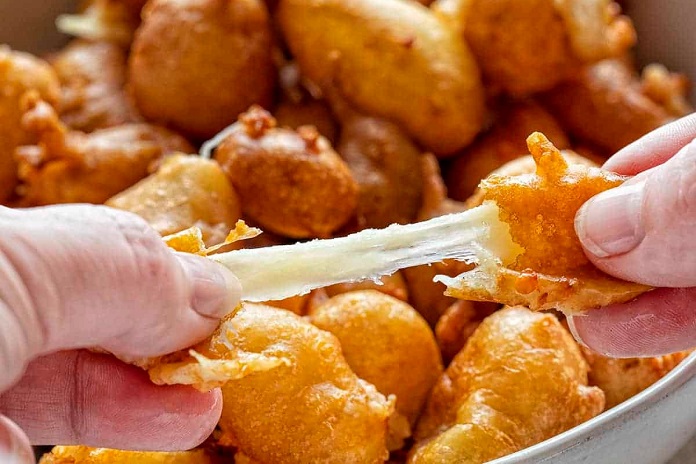On October 15 we celebrate National Cheese Curd Day a day to celebrate, a mild, slightly tangy flavour with a creamy, buttery taste. However, they often have a fresh, slightly squeaky texture when bitten into also, cheese curds are bite-sized nuggets of cheese
Did you know that Culver’s a popular midwestern fast-food chain created this holiday day in 2015, National Cheese Curd day? If you are a cheese curd lover then this article is for you.
History of National Cheese Curd Day
In the year 2015, the celebration of National Cheese Curd Day was organized for the first time. However, it was started by Culver’s the fast food restaurant chain which is located in Wisconsin. Also, the main purpose of this day was to improve awareness of the tasty flavour and irresistible snackability found in their fried cheese curds.
Moreover, culver’s got its start in Wisconsin with burgers in 1984, but they started serving their famous deep-fried cheese curds in 1997.
After that they had expanded outside of Wisconsin and today as of 2024 there are restaurants in at least half of the US states.
| 1100s (Cheese curds make it into a song) | The Celtic song, “Visions of MacGonlannee,” mentioned cheese curds in its lyrics. |
| 1840 (Wisconsin got in on the cheese game) | Wisconsin became the “it” place to make and produce cheese because of its rich farmland. |
| 1922 (Wisconsin’s cheese factories grow) | By this year, Wisconsin was home to more than 2,800 cheese factories. |
| 1900s (Cheese curds gain in popularity) | Because cheese curds grew in popularity, milk factories experienced surpluses in this century. |

Recipe- Homemade Cheese Curds Recipe
Ingredients:
- 4 litres (1 gallon) of whole milk (preferably pasteurized, not ultra-pasteurized)
- 1/4 tsp mesophilic starter culture
- 1/4 tsp rennet (liquid or tablet)
- 1/4 cup cool, non-chlorinated water (for dissolving rennet)
- 1/4 tsp salt (optional, to taste)
Equipment:
- Large stainless steel pot
- Cheese thermometer
- Cheese knife or long knife
- Slotted spoon or ladle
- Cheesecloth
- Large colander
How to make:
- Pour the milk into a large stainless steel pot.
- Heat the milk slowly to 32°C (90°F) over medium heat, stirring occasionally.
- Sprinkle the mesophilic starter culture over the surface of the milk.
- Let it sit for 1-2 minutes to rehydrate, then stir gently to combine. Let the milk sit for 5-10 minutes to allow the culture to work.
- Dissolve the rennet in 1/4 cup of cool, non-chlorinated water.
- Stir the rennet solution into the milk with an up-and-down motion.
- Cover the pot and let the milk sit undisturbed for 45-60 minutes, or until it has set and you get a clean break (the curd separates from the whey).
- Use a cheese knife or long knife to cut the curds into 1-inch cubes.
- Let the curds rest for 5-10 minutes.
- Gently stir the curds and heat them to 38°C (100°F) over a period of about 30 minutes, stirring occasionally.
- The curds should firm up and start to release more whey.
- Once the curds are firm and have reached the desired texture, pour them into a large colander lined with cheesecloth.
- Let the whey drain off. You can gently stir the curds or use the cheesecloth to help drain.
- If desired, add salt to the curds and mix gently.
- Store the cheese curds in an airtight container in the refrigerator. They’re best enjoyed fresh but can be kept for up to a week.
Conclusion
FAQs
What are cheese curds?
Cheese curds are small, fresh pieces of cheese that are formed during the cheesemaking process. They have a mild, slightly tangy flavour and a unique, squeaky texture when bitten into.
Can I use any type of milk for making cheese curds?
For best results, use whole milk that is pasteurized but not ultra-pasteurized. Ultra-pasteurized milk can be too processed for proper curd formation.
How do I know if my curds are ready?
The curds will be ready when they have formed a firm mass that separates cleanly from the whey. Also, you should be able to get a clean break when cutting into the curds.
Why are my cheese curds not curding properly?
There are many factors of why your cheese curds are not cursing where several factors, including the milk’s quality, incorrect temperatures, or issues with the starter culture or rennet.
Can I add flavourings to my cheese curds?
Yes! You can mix in herbs, spices, or other flavourings after draining the whey. Popular additions include garlic, dill, or even a bit of cayenne pepper.
Also, read more about National Pasta Day – October 17, 2024
